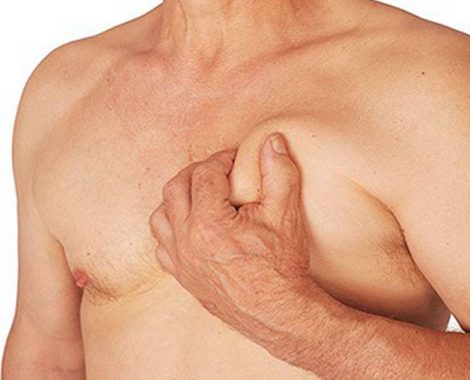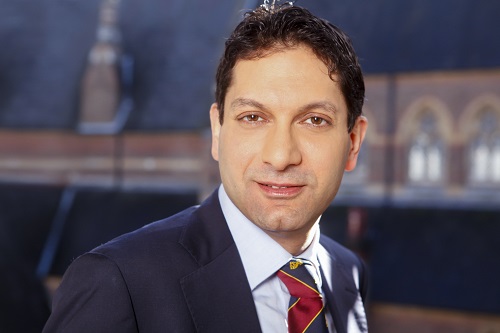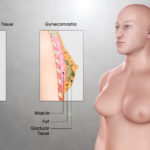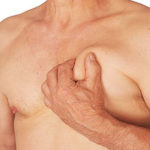Gynaecomastia
Male Breast Surgery (Gynaecomastia)
Gynaecomastia is enlargement of the male breast tissue. It may occur at any time and there are a number of causes, some physiological and others pathological. Pathological causes involve an imbalance between the activity of androgens (this decreases in levels) and oestrogens (this increases in levels).
Nealry 30% of men get affected by gynaecomastia during their life time. The risk of breast cancer in relation to male breast enlargemnt is small, around 1%.
Causes of Gynaecomastia
Physiological
Newborn: resolves after a few weeks.
Adolescence: This is common around the age of 14, may be unilateral.
Increasing age.
Pathological
Lack of testosterone due to congenital absence of testes, androgen resistance, viral orchitis, renal disease and dialysis.
Increased oestrogen levels from testicular tumours.
Neoplasms producing human chorionic gonad such as Adrenal tumours. liver disease, high thyroid levels, obesity, extreme stress.
Medications
- Idiopathic
Investigation
- Blood investigations inlcude blood profies for kidney, liver, thyroid, hormone levels (prolactin, Beta hCG, LH, estradiol, testestrone).
- Utrasound of the breasts.
- Biopsy of the breast
Steps We Take to Reduce Capsular Contracture Rates
- Antibiotic wash for every implant
- Wash the pockets of the implants with antiseptic solutions
- Use one of the best implants in the world
- Use the Keller Funnel as a routine
- All implant surgery preformed in a hospital operating theatre
- Sports bra wearing for 4 months
- Place the implant under the muscle if skin cover is less than 2cm.
gynaecomastia
Gynaecomastia (sometimes referred to as “man boobs”) is a common condition that causes boys’ and men’s breasts to swell and become larger than normal. It can be transient but often it is not. In Some cases it is important to exclude other causes before embarking on surgery. Once any pathological causes have been exlcuded, surgery can be offered as a treatment


causes of gynaecomastia
Hormone imbalance between the sex hormones testosterone and oestrogen. Medications Some anti-ulcer drugs or medication for heart disease. Illegal drugs – such as cannabis or anabolic steroids. drinking too much alcohol . Testicular conditions such as infection or lumps in the testicles. These need to be investigated urgently.
The procedure
The procedure is usually done under a general anaesthtic, however in some milder cases it is possible to do it under a local anaeshetic or sedation. What gets done depends on the severity. In some milder cases liposuction is sufficient, but will need power assisted. In more advanced cases a cut around the nipple areola complex is needed, and in extreme cases a vertical scar as well.
Reviews
What our patients say about us
"The Best Experience Ever"

Start with a virtual consultation
Options for Gynaecomastia
Once medical causes have been excluded, and there is no medical treatment available, most patients will surgical treatment. The treatment depends on how advanced the condition is.
Mild- liposuction alone could be sufficient
Moderate- liposuction plus breast tissue excision
Major- a procedure where the breast is opened to remove the extra breast and skin tissue. There might be a need for a vertical or inverted-T scar.
After Care
The after care following gynaecomastia surgery involves firstly taking some rest. You will need around a week of work and 2 weeks of sports.
You will be asked to wear a tight garment or a tight cycling vest. This needs to be worn 24/7 for around 3 months. This is to maintain the shape and to prevent fluid collection.
The sutures are dissolving in most cases however we need to preform a wound check in around 7 days.
HealthFormation

unilateral gynaecomastia
One sided male breast swelling that is sudden and persistent needs urgent investigating to exclude a pathological cause.
can gynaecomastia resolve
In fact most cases of male gynaecomastia resolve spontaneously, however we would advise that you always get it check out by a doctor.
can gynaecomastia reoccur
In some cases, even after surgery, it can. That is why it is important to take a detailed history and preform a full body medical examination to exclude causes.
Choose Your treatment
Frequently asked questions about Gynaecomastia
The location of the scars depends on the type of surgery. With liposuction there will be small entry sites for the ports of the liposuction cannulas. For more advanced cases a scar around the nipple might be needed. For the bigger cases, scars down the chest wall might also be needed.
There are always potential risks and complications associated with surgery. Complications are rare but can occur. The main complications of breast reduction surgery include:
Bleeding
Bleeding can occur after your procedure and oozing from the wounds is common. Some bleeding can accumulate under the skin resulting in a haematoma or blood collection. Small haematoma will usually resolve with time and may not need any further treatment. Larger haematomas, however, may need a return to theatre to remove them and find the source of bleeding.
Infection
Infection can occur and most often can be managed with antibiotics. Sterile procedures and antibiotics given during the operation try to reduce the risk of infection.
Wound breakdown and healing problems
There are pre-existing risk factors for poor wound healing such as smoking and diabetes.
Scarring
There will be permanent scars on the breast depending on the type of skin incision pattern. Scars can sometimes become hypertrophic or keloid which means they may be raised, red and lumpy. This can occur around the areolar or along all the scars. Patients will usually have a tendency to develop this type of scarring or there may be a family history of abnormal scarring.
Asymmetry
There is always some degree of asymmetry between breasts and nipple areolar complexes. Occasionally, after breast reduction there may be residual asymmetry or patients may become more aware of pre-existing asymmetries.
Change in Nipple Sensation
Due to the nature of surgery and movement of the nipple there is risk of changes to nipple sensation. This is usually reduced nipple sensation after surgery that is often temporary but may be permanent.
Nipple Loss
Very rarely there is risk of nipple loss that can occur when the blood supply to the nipple is disrupted.
Fat Necrosis
Fat necrosis occurs when the fat in the breast loses its blood supply. This may result in firm hard areas where the fat has not survived. Small areas often resolve with time.
Saucer pan deformity?
This is when the breast sinks into the chest wall. In these cases corrective surgery might be needed.
Try leading a healthier life style, such as exercising more regularly, and limiting the intake of processed food and drinks. Eating healthier by including more nutrients in your food.
do you have more questions?




Seen Something Interesting?
We know you are busy, but do not leave without saying Goodbye! If you are interested in our services, simply click below and fill a 10 second quick enquiry, and we will get back to you within 24 hours.
Get in Touch
+44 800 772 3501
hello@cosmeticaestheticplasticsurgery.com

